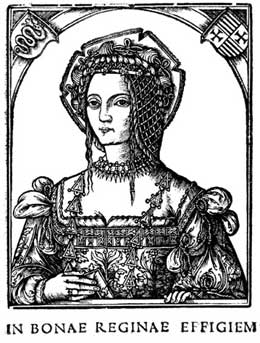
On one hand, Bona has been often criticized for her lack of scruples while achieving political goals and was blamed for contributing to the death of her daughter-in-law Barbara Radziwill. On the other hand, the queen initiated a good political relationship with
Economic initiatives of Bona
The princess of
Bona’s objective was to ensure her own interests and to build a solid financial basis for the future of the Jagiellonian dynasty. She understood that the political power of the throne’s successors needed to be secured with money. Bona spent a lot of time and energy on recovering royal properties that had been in the hands of creditors who charged the state budget mercilessly. In this area Bona’s activities were met with the support of her husband. Sigmund I separated public incomes from the royal budget and paid off rather significant part of the state debts.
Shortly after settling in Poland, the second wife of Sigmund I took the initiative in buying off those royal domains that aristocratic creditors put up for auction. By doing so, Bona pursued her own interests and enforced the authority of her husband. In a very short time, 16 Polish cities and 191 villages were in Bona’s possession. In the 1520s, her properties acquired in
Reforms in the Kingdom and
Internal reforms that Bona conducted in the Duchy of Lithuania were very effective. One of them dealt with the legal basis of land management and involved merging and corrective measurements of estates. Not only Lithuanian villages but also bigger cities were subjected to this reform. Many of them were redesigned: the houses were built alongside the streets according to an orderly plan and not chaotically as they were previously. Administration of royal domains became more effective when villages were grouped under one mayor. More effective agricultural methods also brought about higher crop yields.
Bona made changes in the manner that tributes were paid. Vassals could no longer give material goods and from now on they had to submit cash. This brought about significant incomes for Bona but the procedure had its downside. The peasants had to work harder to supply their superiors and the noble class also noticed financial losses.
Bona’s arbitrariness was met with some critique from her husband, who was against increasing the financial duties of his vassals. At one point Bona and Sigmund I had a very heated argument over this issue. Bona explained her conduct as follows: „The tributes that Your Highness’s father established are ridiculously low. Three years ago I asked of my representative Grzymala to increase them. This year I made a similar request. I made it clear that my will must be obeyed.” The King commented in this manner: „This was not the right order, believe me. The last few years were very difficult for renters; hails destroyed the crops last year and the snows of this winter spoiled the cereals. The snow lingered until Pentecostal Sunday. The people were eating weeds. Is the king to be the tyrant and not the father to his people”? The riposte of the Queen was quick and nasty: „Polish monarchs are such magnanimous rulers; they are always ready to give away goods and to reward vassals in order to buy their love. They do not care about tomorrow and when tomorrow comes, the royal treasury will be full of virtues but otherwise empty. The royals in my country do not do such things and their example I am willing to follow. When the cradles of the treasury are full of money I can buy military power and keep my people under the iron hand. The monarchs in
Bona put a lot of effort into speeding up the development of cities that belonged to her. She granted city dwellers privileges that made their position close to the noble class. She invited Italian architects and Polish master builders, who erected new forts, churches, monasteries, bridges and channels and also reinforced the infrastructure of existing cities. The buildings that came into being during Bona’s times can still be admired in some Ukrainian cities.
In 1545 Bona exchanged her dowry for the real estates in the Mazowsze area. She gained ownership of 35 new cities and 253 villages. Her management talents could be seen in developments of trade and manufactures. The city life became more dynamic. Bona’s initiatives were particularly beneficial for cities such as
Hostility of the noble class
Restitution of royal estate properties was against the very interest of Polish magnates and the noble class. Legally there was nothing wrong with this procedure and the middle noble class previously agreed with it. What particularly bothered the noble class was that the royal family treated incomes from the royal domain as their private money and did not support the state with it.
In the late 1530s, the protests of the noble class took the form of parliamentary quasi-constitutions, which limited the ability of royals to re-buy their previously lost domains. During the 1544 parliamentary session, Lithuanian magnates fiercely opposed against Bona’s economic policy.
Shortly before Bona left
Fighting for the succession of the Italian throne
Throughout her stay in
Bona left
Returning to
Bona’s economic efforts deserve a lot of appreciation, even though the Queen was unable to avoid some mistakes. Increase of rent resulted in a better state budget. This was achieved through putting more demands on peasants but it only minimally affected their economic position. Bona managed her estates very well but many of them faced financial ruin after her departure. Bona’s fortunes acquired in
